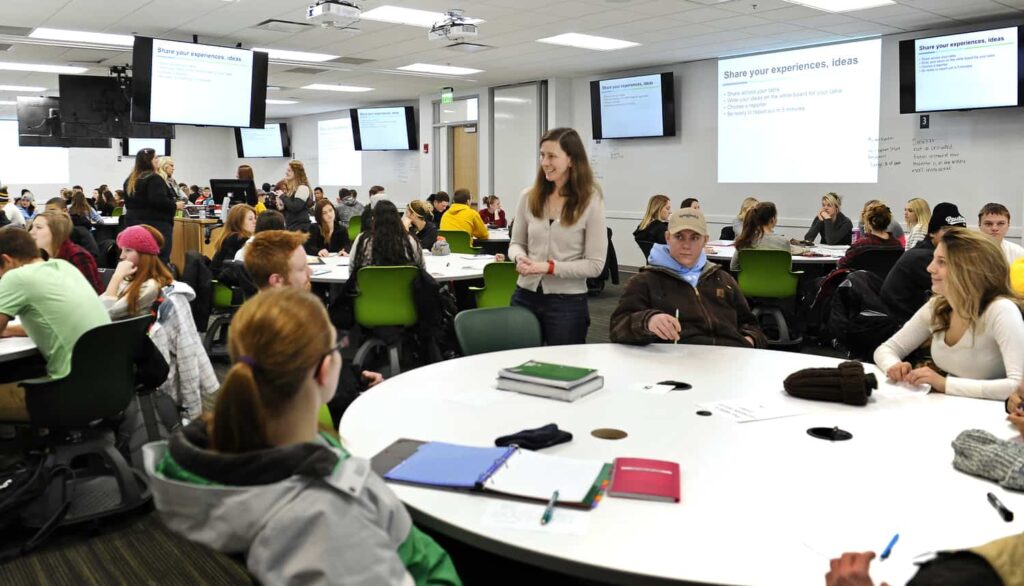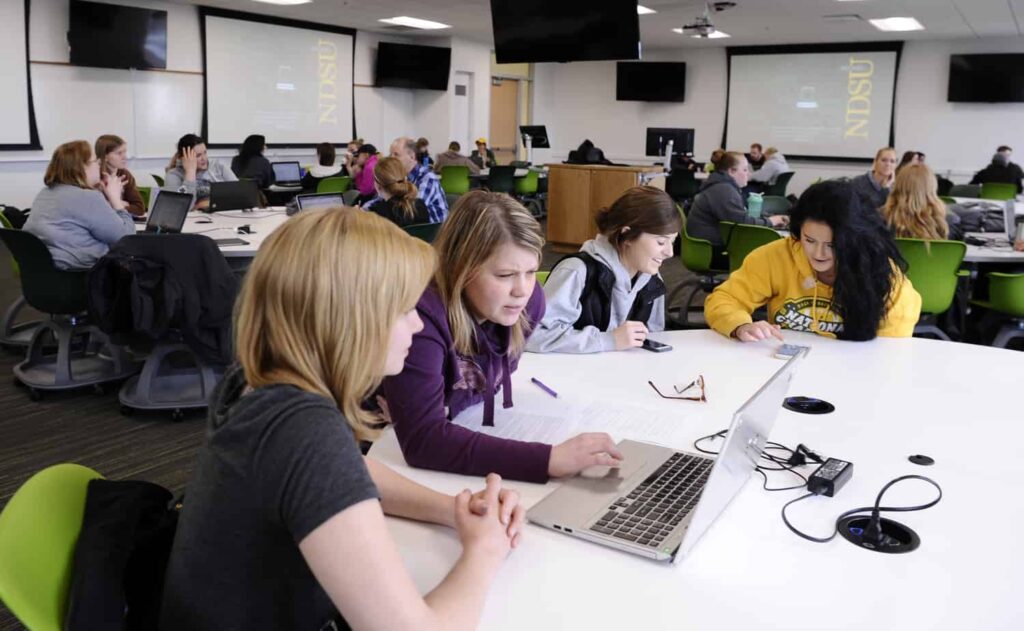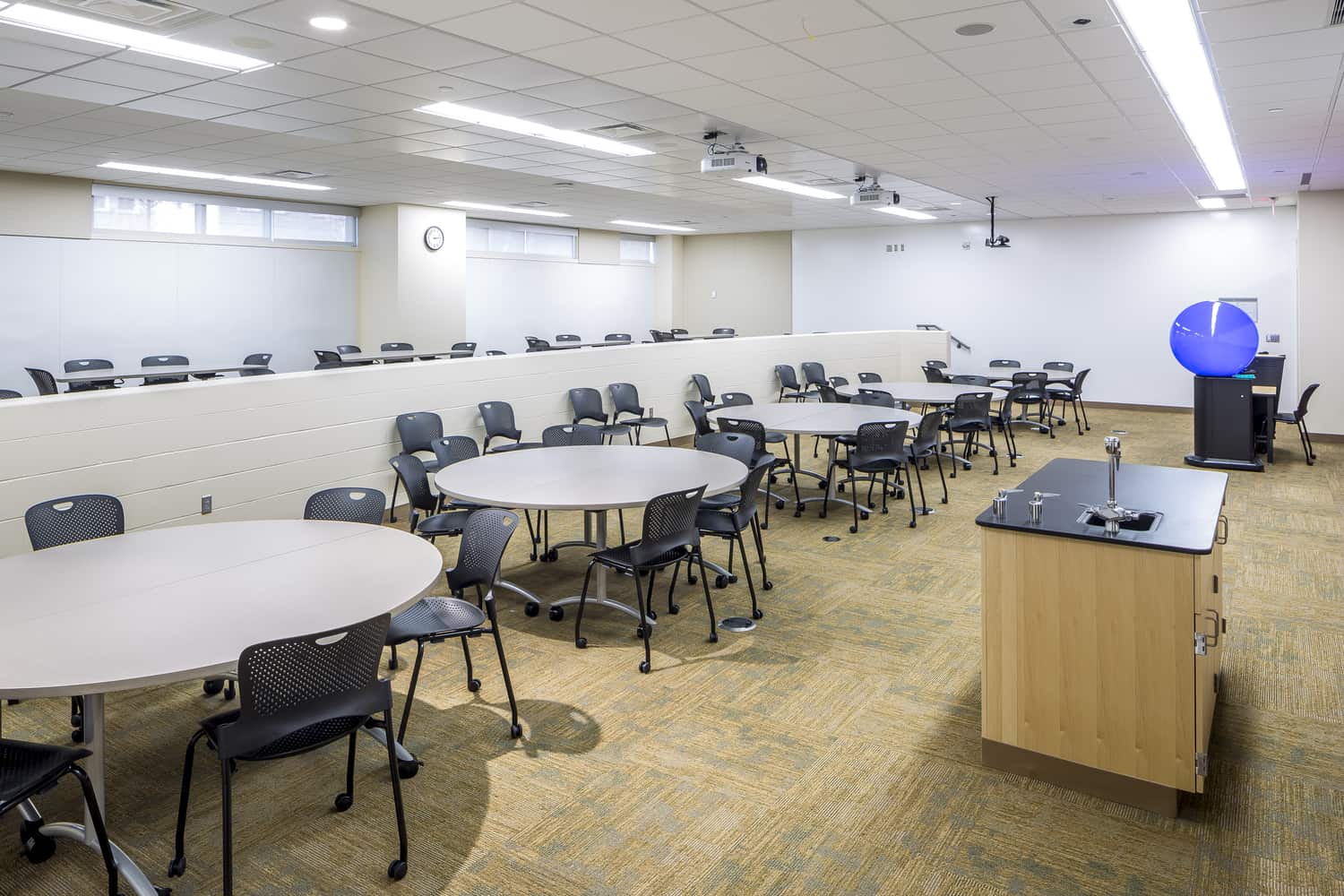Active learning strategies are becoming more and more common in higher education classrooms, and that’s because they’re proven to work. For example, one of the more comprehensive studies found that students in active learning classrooms had higher exam scores and grades by half a letter. In addition, failure rates in active learning classes were lower. Those are some pretty good results, which is why we wanted to offer a few ideas on how design plays a role in active learning.
Active learning
Active learning is an instructional technique that gets students more engaged in the learning process. The technique is all about having students perform learning activities in the classroom — mostly in groups, but sometimes alone, too. In this hands-on approach, teachers introduce an activity (writing, reading, group problem solving). Once the class gets going on the activity, the instructor acts as guide, posing and answering questions throughout class. These activities help students construct their own knowledge, motivating them to develop thinking skills and paying off with better content retention.
Designing for active learning
Because active learning has been so successful, the need for designing classrooms that support it is in high demand. To help flesh out these design needs, there are several questions we ask our clients.
1. How many students should the room accommodate?
Active learning classrooms were originally designed for bigger classes, (referred to as TEAL and SCALE-UP), as a way to improve learning and retention in large lecture classes. It’s common to see active learning classes of over 100 students. Active learning principles can apply to all class sizes and that’s why it’s important to assess room size first. As a general rule of thumb for classroom design, we plan 25–30 square feet/person.
In addition, we also need to understand the potential group sizes faculty think they may need to accommodate in their classrooms. Studies show that group sizes of 3-5 are best. Any fewer and it’s not a group; any larger and students may be likely to sit back and not engage. If there is a specific group size desired, then the table configuration can be designed to be flexible and accommodate that particular need. For example, a five foot long rectangular table to accommodate two students is very common, but push two tables together and you’ll have table ready for a group of four. A large round table for 3 groups of 3 is common in rooms with fixed monitors and power/network connections.
2. What is the predominant learning activity the room should support?
Our goal is to provide classrooms that support a wide variety of learning activities — and we can do that to a large degree. However, a room optimized for lecture-based learning is not the same as a room that is optimized for problem-based, group learning.
Active learning classrooms typically favor collaboration-based learning models. Students need a design that allows them to have group discussions, think-pair-shares, brainstorms, or peer reviews. They also need to be able to separate to do solitary writing activities. Wheeled tablet arm chairs or moveable tables provide students the most ability to change their postures and group sizes throughout class.

Even with all this collaborative learning, we know that lecture is still popular as a content delivery method. We need to be able to support lecture-based learning with good sight lines to boards and screens. To make a lecture-style, tiered classroom flexible for active learning, we can incorporate two tables per row of chairs so that students in the front row can turn around and gather in a small group with the students sitting behind them.
3. How can students make their thinking visible?
Classrooms can give visibility to students’ thinking in a number of ways. Vertical writing surfaces can be incorporated on as many walls as possible. Students can sit or stand around the marker board while solving a group problem. Studies show that we are more active in the conversation when we are standing.
Freestanding moveable marker boards can also be used to make thinking visible and also provide some separation between groups. Additionally, handheld whiteboards are a good option and allow students to solve a problems at their tables, and then report out to the larger group with visual aids.
More and more we are also including monitors on the wall to allow students to work out problems on their device during and after class. These monitors can be setup to push instructor content out to all the monitors (helping with sight lines to content). In addition, they can be setup to pull content from the students to share with the whole class.
Teachers also use clickers technology to engage students by quizzing them in the middle of class. Faculty can quiz the students at the beginning of class to ensure they comprehend the key concepts from the reading or flipped lecture. If there isn’t clear understanding by the majority of students, the instructor can give a mini lecture on the specific topics and then quiz again.
4. How flexible should the furniture be?
An instructor once shared with us, “if you fix the furniture, you fix the thinking.” We not only strive to create a design with flexible furniture to support a variety of learning activities over the course of one class period, but also a variety of teaching styles over the course of the semester. With the ideal design, students and instructors should be able to shift from lecture to group work to individual work all within one class period. The Steelcase Node chair is one example of furniture that has many benefits in an active learning classroom. Faculty and students can move from lecture to group work in a matter of seconds. Swivel seats mean students can easily shift their attention to any part of the room. Student gear fits on the extra-large tablet arm and what isn’t needed during class is stored right in the base of the chair.
5. What type of technology will the students need?
If student monitors are desired in a classroom to help making thinking visible, we need to provide a way for students to connect to these monitors. The most fool-proof way is to have a fixed table with an HDMI connection in the table to the monitor. We can also provide an HDMI port at the wall for the students to connect to. And finally, wireless connections are becoming more stable. Click Share and other platforms allow students to connect their device without the hard-wired connect (just be sure to collect the Click Share device when the students leave class).
Get started designing your active learning classroom
Designing an active learning classroom starts with asking a few questions and understanding the needs of your organization. There are many ways to create an active learning classroom and it doesn’t always require a big renovation. It can be done as a pilot in one space, or in stages, tweaking the design after testing. The good news is, because we know active learning works, even the smallest design change will be worth the effort.









